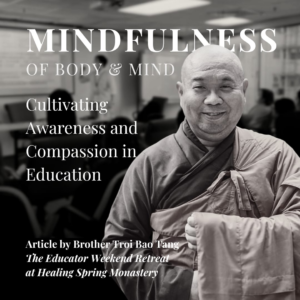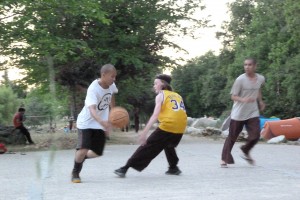
In the serene setting of Healing Spring Monastery, two weekend retreats were held in April 2025 for teachers and educators in English and French. This retreat explored deeply mindfulness of the body and mind in daily life, a fundamental practice in the Plum Village tradition. In the last teaching, Br. Troi Bao Tang emphasized the importance of recognizing and embracing our inner experience both pleasant and unpleasant and highlighted the vital role we all play as transmitters of knowledge, values, and compassion across generations.
The Role of the Teacher Within Us All
In the Plum Village tradition, the term “Thay” means teacher, but it extends beyond spiritual teacher. Every person is a teacher in their own way, passing on wisdom, habits, emotions, and ways of being to those around them. Whether through formal teaching or simply by living authentically, we influence the generations that follow us and heal the ones before.
The retreat began by acknowledging this universal role: Everyone has a teacher inside of us,Br. Troi Bao Tang explained that We come from a generation before us, and there are generations after us. The children and younger people today are our descendants, whether genetically or through generational transmission.
This view invites a deep sense of responsibility. Our actions, emotions, and mindfulness practices are one of the gifts we pass forward, transforming the future. Teaching, therefore, is not limited to classrooms but is a continuous transmission of our entire being, our happiness, our suffering, and our awareness.
Transmission: Conscious and Unconscious
Transmission of knowledge and emotions can happen consciously or unconsciously by automatic pilot and habit energy. Sometimes we unconsciously pass on suffering or unwholesome habits because our minds are not fully awake to what is happening inside and around us in the present moment. Br. Troi Bao Tang illustrated this with a beautiful metaphor: like a bird carrying a walnut to eat, but the walnut falls in a field and a new tree grows there, without the bird consciously planting it.
This unconscious transmission can perpetuate cycles of suffering unless we cultivate mindfulness. Mindfulness helps us become aware of our inner landscape so that we can consciously choose what to contribute to others.
Mindfulness Practice Beyond Curriculum
The retreat highlighted that the Plum Village tradition is less focused on formal educational Curriculum and more on cultivating the awakened mind in the education environment & building the beloved communities. The aspiration is to help individuals recognize their emotions and mental states and learn to take care for them skillfully, first of all ourselves. One of the key teachings was that body and mind inter-connected. Through mindfulness of the body in the body such as sitting, walking, or breathing, we can begin to observe the subtle feelings and mental formations arising within us.
Understanding the Mind: The Four Aspects
Br. Troi Bao Tang introduced an ancient Buddhist way for understanding the mind, dividing it into four areas:
1. Feeling (Vedana) : The sensation of pleasant, unpleasant, or neutral feelings.
2. Mental Formation/ mind(Sankhara) : The emotional and volitional responses, such as anger or happiness.
3. Perception/ object of mind (Samjna) : How the mind recognizes and names objects and experiences of each senses – Eyes,ears,nose, tongue, body, mind.
4. Consciousness (Vijnana) : The contact between the senses (including the mind) and the
objects they are in touch with.
This simplified model helps practitioners observe their experiences with clarity and compassion.
Feelings: Pleasant, Unpleasant, and Neutral
Feelings are fundamental to our experience but often go unnoticed. The retreat included a practical exercise to help participants become aware of feelings by breathing in and out with the sensations arisen by simple words or images, such as apple, spider, flowers or lemon juice. Participants were invited to recognize whether the feeling was pleasant, unpleasant, or neutral, and to breathe mindfully with every sensation. This practice cultivates the awareness that can prepare us to face difficult emotions without running away or suppression.
Mental Formations and Perceptions
Mental formations are our mind formed by our condition, such as anger, gratitude, compassion or anxiety. Perceptions /object of mind are how we interpret and label these experiences.
For example, when you say I am angry, the anger is a mental formation. When you observe your anger mindfully, it becomes the object of your mind, allowing you to hold it with openness and care.
Training ourselves to recognize and name these different mental formations early gives us the agency to respond skillfully rather than react unconsciously.
Consciousness: The Contact Between Senses and Objects
Consciousness in Buddhist psychology refers to the contact between our senses (including the mind) and the objects they perceive. There are six senses: five physical (eyes, ears, nose, tongue, skin) and the mind as the sixth. Each sense has a corresponding consciousness that arises when it meets its object. This understanding encourages a grounded, experiential approach to mindfulness rather than abstract concepts of consciousness. The purpose to understand these 4 areas is to help us in our mindfulness practice.
Practical Exercises: Breathing with Feelings and Emotions
The retreat offered several breathing exercises to help participants develop mindfulness of their body, feelings and mind. For example, breathing in and out while recognizing the joy of freedom, the feeling of anger, or the feeling of gratitude. Such exercises enable us to embrace all feelings, including unpleasant ones, rather than unning away or suppressing them. Recognizing and breathing with difficult emotions is a powerful way to cultivate resilience and peace.
The Path of Gladdened, Concentrated, and Liberated Mind
Br. Troi Bao Tang outlined four essential steps to breathe with the mind:
1. Awareness of the Mind: The capacity of recognizing and naming the feelings and mental states as they arise.
2. Gladdening the Mind: Cultivating acceptance and mindful of the presence of good conditions alongside the difficult condition.
3. Concentrate the Mind: Staying with the mind to understand the roots and causes of emotions deeply. (Mindful Investigation on phenomena)
4. Liberate the Mind: Gaining insight that dissolves suffering and attachments through understanding.
These trainings are crucial because many of our difficult emotions arise from incomplete understanding or misperceptions. For instance, anger often stands from misunderstanding. By investigating these feelings with concentration and compassion, we can free ourselves from unnecessary suffering.
Sharing Stories from the Teachers Community
The retreat also featured heartfelt sharing from educators who have integrated mindfulness into their personal and professional lives. One participant, Karin, a volunteer in Wakeupschool international community, described beginning meditation to address personal suffering and gradually building a stable practice supported by a mindful teacher community (Sangha). She emphasized the importance of community for sustaining practice and supporting one another, especially for teachers facing stress and challenges in their work.
Another teacher, Ira, a volunteer in Wakeupschool international community, shared her path from initial struggles with stress. Her story highlighted how embodying mindfulness can transform everyday moments, such as walking mindfully to a classroom, creating a space of calm and presence for both teacher and students.
Embodying Mindfulness in Daily Life and Teaching
Ultimately, the retreat reminded us that mindfulness is not just a practice, but a way of being that teachers and educators can embody and share. Whether in formal classrooms or daily interactions, cultivating awareness of body, feelings, mental formations, perceptions, and consciousness allows us to transmit peace, understanding, and compassion.
As Br. Troi Bao Tang reminded participants, don’t learn too much. Just do it. The invitation is to bring mindfulness into daily life, to breathe with whatever arises, and to recognize the power we have as teachers, not only of knowledge but of presence and love.
The Gift of Mindfulness for Teachers and Beyond
The teachings shared at Healing Spring Monastery offer a profound reminder that mindfulness of body and mind is essential for personal and professional well-being. By learning to recognize and embrace our inner experiences with kindness and clarity, we become better equipped to support others and to pass on a legacy of compassion and understanding.
For educators, this practice is especially powerful, as it nurtures resilience in challenges and strengthens authentic connection with students and colleagues. Through mindfulness, we can transform not only ourselves but also the communities and generations we serve. For those interested in exploring these teachings further, Healing Spring Monastery offers retreats and resources to deepen mindfulness practice in the Plum Village tradition.
Explore more:
[Healing Spring Monastery Website]
(https://healingspringmonastery.org/
[Support Healing Spring Monastery]
(https://plumvillage.org/practice-centre/healing-spring-monastery#donate)
[Upcoming Retreats and Events]
(https://plumvillage.org/practice-centre/healing-spring-monastery#retreats-events)
Video :
Mindfulness of Body in the Body
In English : https://youtu.be/meFMbUck0No?si=IQWtxRQeLzTWHaC1
In French: https://youtu.be/5FXYMySS-b0?si=K5xXSOgYLh9bek0f
Mindfulness of the Mind in the Mind
In English: https://youtu.be/TZkLyviYcXQ?si=ghVopiabXaWrHmqm
In French:
Sharing from Teachers :
https://youtu.be/aXgHXeUGTDk?si=0WtUTiJ_Sj7Zyv5J

